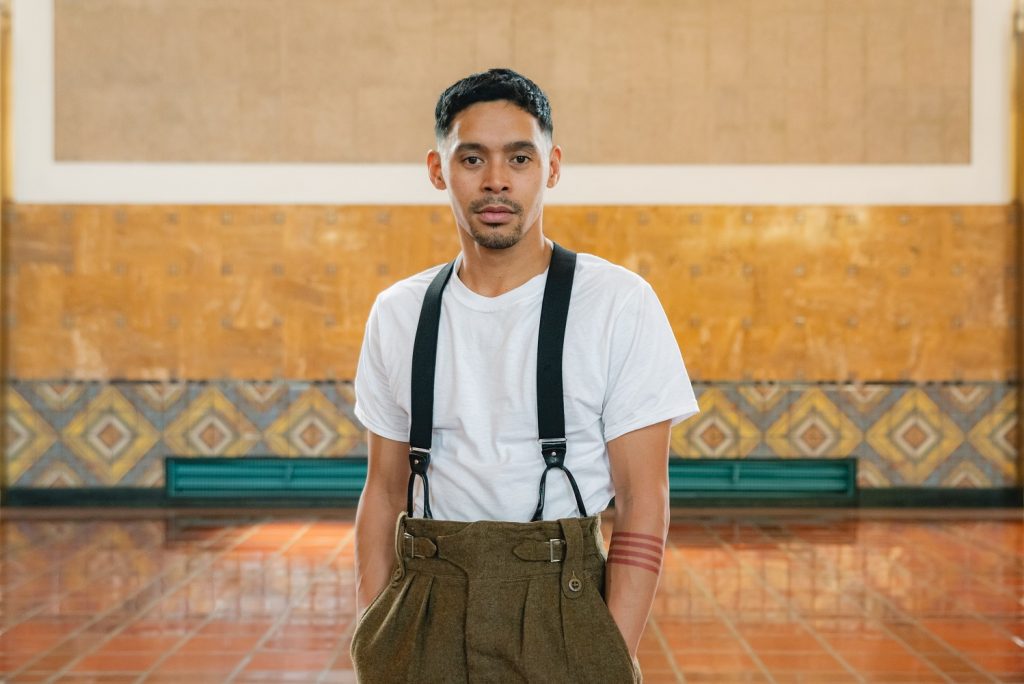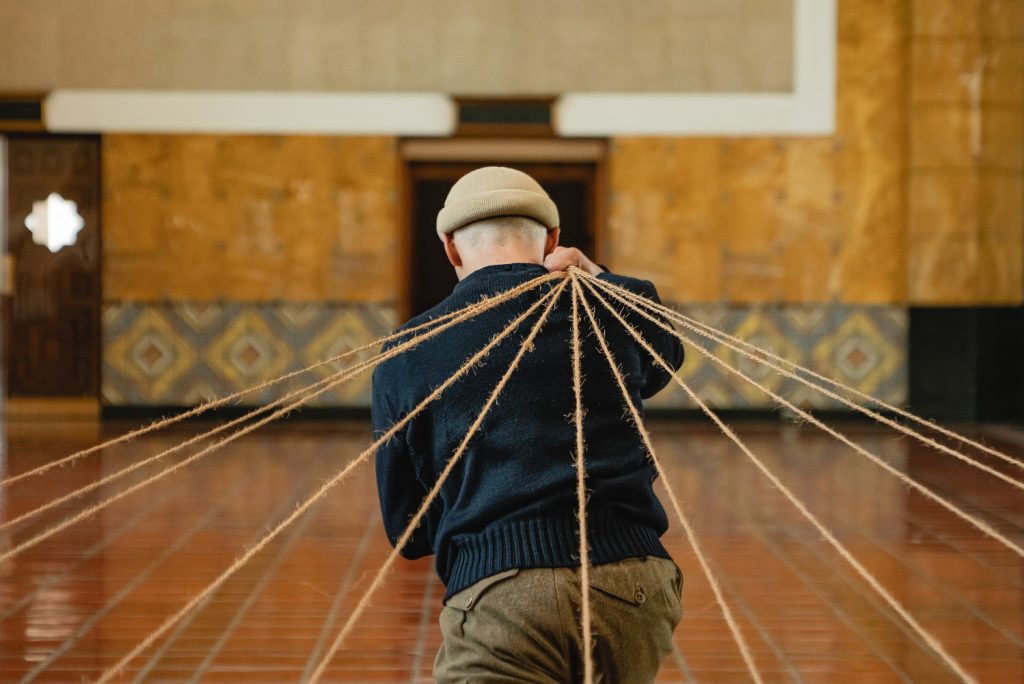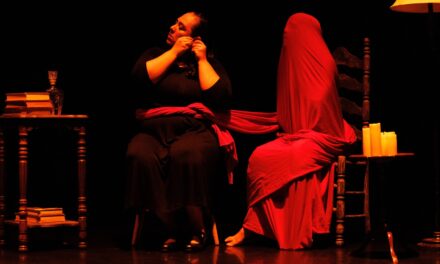Jay Carlon is a Los Angeles-based independent dance artist who has definitely made his mark with his poignant site-specific work as well has his theater performances at REDCAT and LA Dance Project’s studio theater 2245. Awareness of Carlon’s work is expanding outside of LA and in 2020 he made the “25 to Watch”, an annual list published by Dance Magazine of young, talented, and trend setting dancers, choreographers, and new dance companies. On Thursday, April 22, 2021, Metro Art presented the premiere of Carlon’s theatrical dance work for film BAGGAGE. Filmed in the historic Ticketing Hall of LA’s Union Station, BAGGAGE was the fourth and final program of Moving Through – A Month of Dance + Movement for Times of Change series which began on April 1, 2021, produced in creative collaboration with Pieter Performance Space and featured four dance artists who utilized several areas of LA’s beautiful Union Station. The other artists whose work appeared on Moving Through were Joy Alegria, Chard Gonzalez, and Emiko Sugiyama.
BAGGAGE opens and closes with the Philippine Proverb “A person who does not remember where they came from will never reach their destination”. The press release states that Carlon “celebrates origin stories and embodies the many histories of arrivals and departures at the station and in our lives”, it is, however, also a very personal work for Carlon with its inspiration deeply rooted in his family history. Many migrates pass through terminals in the US, including Union Station, and Carlon channels those travelers via his own family story.
The youngest of 12 children, Carlon was born and raised in the agriculturally rich Central Coast of California. At age 19 Carlon’s mother was forced into a marriage to a much older man with children by a previous wife, and after only a few months moved his family from the Philippines to America. Carlon’s mother’s first job was harvesting strawberries. During the film, BAGGAGE, we hear his mother, Lolita, describing this time in her life and again later as she leaves messages to her son, whom she calls Ly, on his answering machine. They are messages of concern for his safety during the pandemic and social justice protesting occurring here in Los Angeles.
In 2019, Carlon presented his evening long work FLEX that was created and directed by Carlon and developed and supported through LADP/MAKING:LA Residency Program. It was a powerful work of dance theater dedicated to his parents and paid homage to all immigrants who have and continue to face, prejudice, bigotry and other adversities from people in a new country. FLEX referenced a little known story of the Filipino-American War of 1899-1902; a war that the majority of history books fail to mention. The war was a genocide, roughly 9 million people, carried out on the people of the Philippines by the USA.
As with Carlon’s site-specific works , in BAGGAGE the viewer is allowed to see the production crew and the equipment involved in the live performance by electronic composer Alex Wand. Even though it is a film, this process transports one into the work and takes one step closer to actually experiencing Carlon’s site-specific piece in real time.
I first asked Carlon how he was doing when we connected for a telephone interview because I knew that he had very recently lost his grandmother and his eldest half-brother who was from their father’s first marriage. He mentioned being grateful to have his art to channel his grief into, and that because he was unable to have physical contact with people during the pandemic that he felt that he was actually choreographing the unseen. BAGGAGE is dedicated to his brother Albert who passed away just days before his 74th birthday. Albert died very near Union Station while Carlon was creating this work.
Carlon had recently been involved on a film project with choreographer, dance, performer and social activist Suchi Branfman titled Dancing Through Prison Walls During a Pandemic. “With mental health being a hot word,” Carlon said. “I’ve been focusing on healing and inter-generational trauma. Whether its mental illness, displacement, homelessness or incarceration, all these things came up for me working on BAGGAGE as well as working with Suchi.” Carlon discussed how he felt that working on these two films has made him realize that he had to confront some difficult personal feelings related to his family’s past.
I inquired whether or not BAGGAGE was an extension of or inspired by his earlier work FLEX. After a pause, Carlon answered “Yes. I almost feel like BAGGAGE is a part of a longer series of work that I’m calling REFLEX.” Before he created FLEX, Carlon considered most of his work more abstract. Currently, because he feels that it is necessary right now for Asian identities to be told via an Asian voice, he wants to saturate the dancers he works with his own identity and his personal stories. “After FLEX, I felt empowered that my unique story was even more universal than I thought,” Carlon said. The making of FLEX helped him realize that the more specific he went, the more universal he was. It gave him the confidence that he was a storyteller. For those of us who have watched his work through the years, we have known this to be true all along.
In reading about BAGGAGE, I saw that Carlon had done extensive research and I asked him how this had influenced the work or him.
“The research that I’ve been doing for BAGGAGE,” he said. “is the research that I have been trying to uncover with my own life and trying to decolonize my practice – my dance practice, all my practices, my food practice, my spiritual practice.” He said that FLEX was primarily his father’s story, but that BAGGAGE is steeped in his mother’s story. The research brought up difficult family, interracial and other personal memories which, like the majority of artists, Carlon assimilated into his work. He said that the experience had been emotionally liberating.
Alex Wand, who Carlon has been collaborating with since he began creating site-specific work, is a Grammy Award-winning musician and composer. He also performs solo and with the bands Desert Magic and the PARTCH Ensemble. Carlon said that he not only wanted to integrate the sound into the site but also into the movement. He and Wand accomplished this via contact microphones that were placed inside the suitcases and, in the final section, directly onto Carlon’s clothing and body. The two had used this method in other of Carlon’s works at the Annenberg Community Beach House, a Los Angeles Dance Festival performance and in his work titled fold, unfold, refold which he choreographed in collaboration with Lindsey Lollie and performed at REDCAT.
Carlon explained that as he dragged the suitcases around with the mics inside, the sound became distorted, “like distorted memories or how memories get distorted when you reopen them,” He said. “Or even conflated a bit.” Because Wand was composing live as the work was being filmed, Carlon felt like he was also a musician because when he maneuvers the suitcases about it activates, creates and reshapes the sound. Wand used an electronic synthesizer to compose the sound created by this process.
During the film Carlon is seen tethered to an old suitcase and numerous others lying about. We all can relate to lugging a heavy suitcase through a train station or an airport, but this film takes on another item that we universally share – the carrying of family or other life baggage that brings stress into our lives. We see Carlon’s burden increase as he pulls eleven suitcase around the station’s ticketing area. He crawls and walks on his hands through a web of the ties to the baggage he bears and periodically investigates the contents of a certain piece of luggage. What inside these memories need dealing with, settling, or letting go of?
The final scene in BAGGAGE is extremely moving. The music that he creates by running his hands over the contact microphone attached to his chest sings out the emotions that Carlon is experiencing as he moves across the space and the suitcases are carried away one by one – slowly letting go of one piece of self at a time. Carlon slowly settles to the station’s dark red ceramic floor and lies in a bright pool of natural sunlight. There we witness the painful joy of letting go quietly move across his face. Knowing of his brother’s passing, it was difficult not to think that he was also saying goodbye to his eldest sibling who has passed on to whatever realm awaits.
BAGGAGE is a film by Jay Carlon with music composed and performed by Alex Wand. Technical Director and Editor was Ernie Mondaca; Director of Photography and Color was Oleg Tcherkas; Production Sound Mixer was Cristian Valencia; Production Assistants were Dora Ramos and Geovanny Pulido; Camera Operators were Dylan Martz, Fernando Rosales, and Paula Crichton; Gaffer was Damon Nash White; Intro Voiceover was Annielille Gavino; and Production and Creative Support were Dorothy Dubrule and Brian Sea. The interview with Lolita Carlon and her sons by Professor of Ethnic Studies, Grace I. Yen, occurred at the Loonanon Pioneers Fiesta in 2013. It is part of the Re/collecting Project Archive, special collections and archives California Polytechnic State University San Luis Obispo.
To watch BAGGAGE, click HERE.
To visit the Carlon website, click HERE.
To learn more about Metro Art, click HERE.
To visit the Pieter Performance Space website, click HERE.
Written by Jeff Slayton for LA Dance Chronicle.
Featured image: Filming of Jay Carlon’s BAGGAGE – Photo by Fara Sosa











